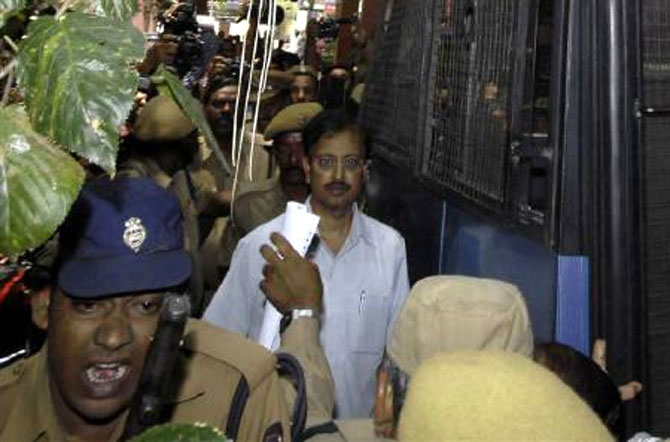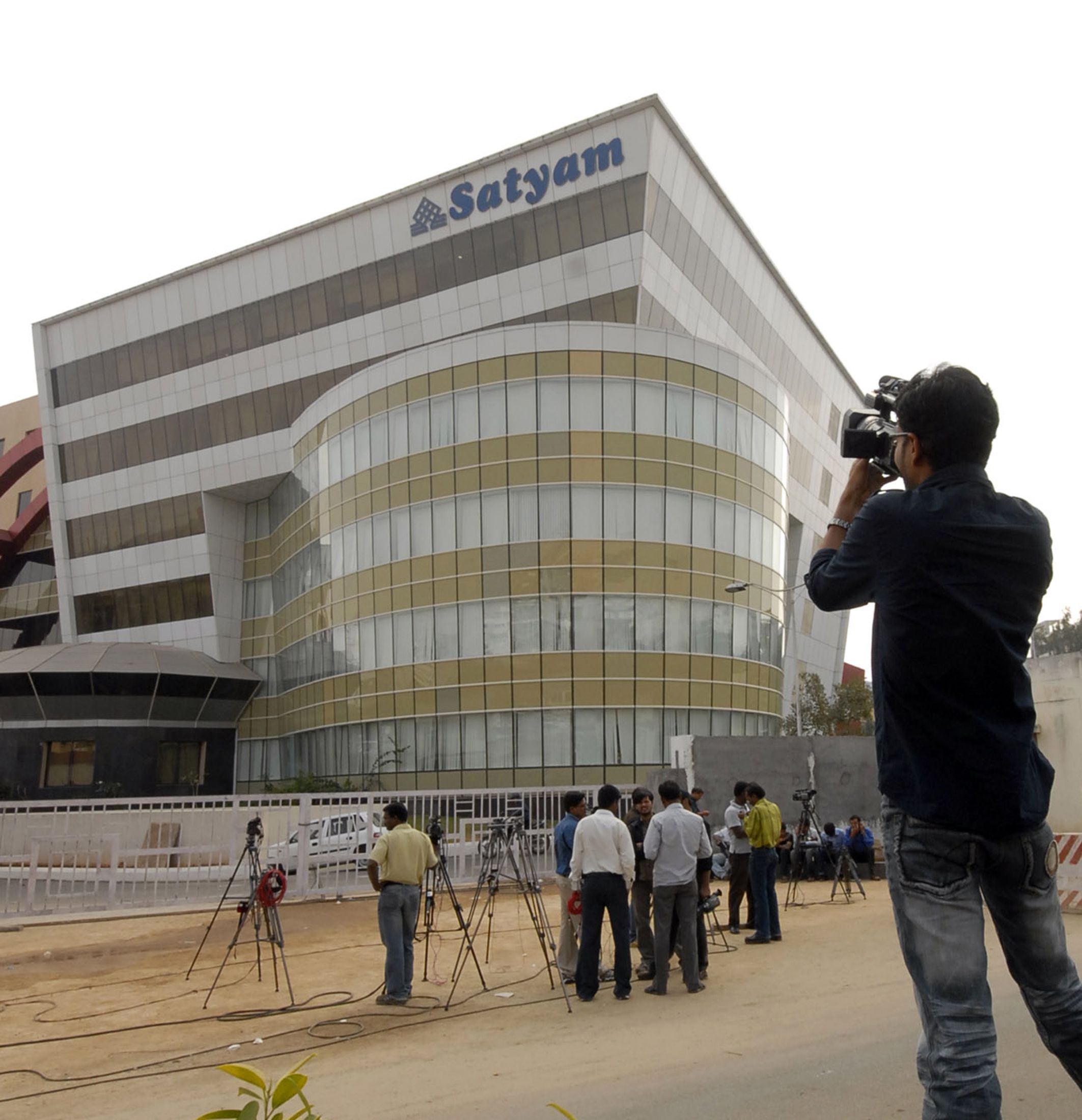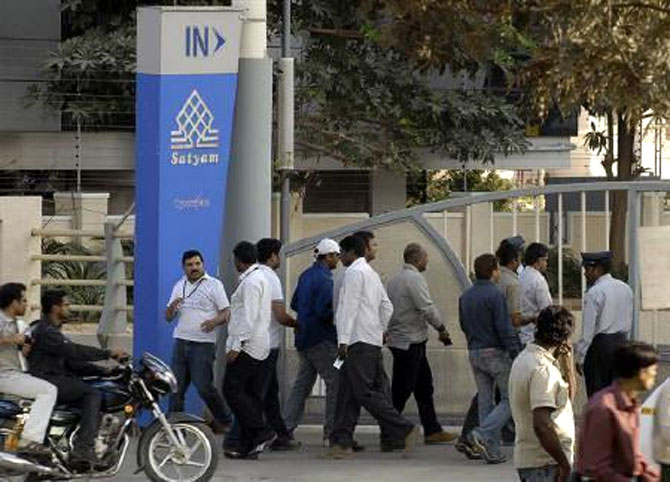Photographs: Krishnendu Halder/Reuters Paranjoy Guha Thakurta
The Satyam case highlights how a sluggish judicial process has thwarted the efforts of a government authority to attach financial assets of a scam-tainted corporate entity, says Paranjoy Guha Thakurta.
Here's a classic case of how the attachment of proceeds of crime can be delayed and how attempts by revenue authorities to recover laundered money can be frustrated.
Here's a story about the working of the judiciary and corporate India. What follows is a tale about a once-notorious company, Satyam Computers, now in a respectable new avatar, Tech Mahindra.
The company has so far succeeded in ensuring that a not-exactly-piffling amount of Rs 822 crore (Rs 8.22 billion) -- described as proceeds of crime by the Enforcement Directorate (ED) in the department of revenue, ministry of finance, Government of India -- remains unattached. Reason: the criminal case against Satyam relating to money-laundering has meandered through no less than 10 sets of judges in less than two years.
This is the single biggest attempt by a government agency to attach a company's financial assets in the form of fixed deposits in banks. In terms of total asset value, however, the biggest attachment made by the ED so far has been the factory and other assets of Gali Janardhana Reddy, the disgraced mining baron from Bellary, Karnataka, who was a former minister in the B S Yeddyurappa government.
 The Satyam scam, often called India's biggest corporate white-collar fraud, broke out on January 7, 2009. That was the day the Hyderabad-based, 59-year-old Byrraju Ramalinga Raju, image, left, admitted that he had fudged the accounts of his flagship firm, Satyam Computers and Services Limited, to the tune of Rs 7,136 crore (Rs 71.36 billion), including Rs 5,040 crore (Rs 50.40 billion) of "non-existent cash and bank balances".
The Satyam scam, often called India's biggest corporate white-collar fraud, broke out on January 7, 2009. That was the day the Hyderabad-based, 59-year-old Byrraju Ramalinga Raju, image, left, admitted that he had fudged the accounts of his flagship firm, Satyam Computers and Services Limited, to the tune of Rs 7,136 crore (Rs 71.36 billion), including Rs 5,040 crore (Rs 50.40 billion) of "non-existent cash and bank balances".
Since then, Ramalinga Raju, the founder and promoter of Satyam Computers, a $6 billion information technology company, has been in and out of jail. On November 4, 2011, the Supreme Court had granted him bail since the Central Bureau of Investigation had failed to file charges against him within the stipulated 90 days of his arrest.
On October18, 2012, the joint director of the ED in Hyderabad passed a provisional attachment order for "proceeds of crime in the form of fixed deposits" worth Rs 822 crore (Rs 8.22 billion) against 40 companies that had been promoted by Raju, his family members (including his brother, sister-in-law and his children) as well as his associates (including his gardener, of all people).
Please click NEXT for more...
The curious case of money laundering by Satyam Computers
Image: Raju after he was arrested.Photographs: Krishnendu Halder/Reuters
Two years earlier, the ED had filed an Enforcement Case Information Report in this case which is akin to a first information report lodged with the police.
These 40 companies, the ED alleged, had loaned the money to Satyam Computers a short while before Raju’s business empire collapsed. The funds, it is claimed, had been illegally generated and thereafter laundered, the transactions coming under the purview of provisions of the Prevention of Money Laundering Act, 2005.
A chronological account of what transpired follows.
Tech Mahindra, which took over Satyam Computers Services Limited (SCSL), did not let the ED order go uncontested. On December 4, 2012, Tech Mahindra (on behalf of SCSL) filed a writ petition in the Andhra Pradesh high court before Justice Sanjay Kumar. Exactly a week later, on December 11, the judge stayed the ED's provisional attachment order for the fixed deposits worth Rs 822 crore.
On January 4, 2013, the ED filed a writ appeal before the high court against the stay order. On February 6, 2013, the matter came up for hearing before the bench of the then chief justice of the Andhra Pradesh high court Justice Madan Mohan Lokur (who is now a Supreme Court judge) and Justice B N Rao Nalla.
Though the ED sought an adjournment for only a day for the then Additional Solicitor General Mohan Parasaran to argue the case on its behalf, hearing on the case was posted for March 22, 2013, on the request of the lawyer appearing for SCSL.
As Parasaran assumed charge as Solicitor General of India, he apparently did not find time to appear before the court and Vikas Garg (who was on a panel of lawyers of the ED) was appointed to appear for the directorate. Taking note of this development, a bench of the court comprising Chief Justice P C Ghosh and Justice N V Ramana posted the case for hearing on April 3, 2013.
On that date, the lawyer for Satyam, A K Ganguly, sought an adjournment on the ground that the senior counsel was absent. The bench then adjourned hearing on the case to April 15, 2013. That day, ED's lawyer Garg opposed the adjournment sought by SCSL from the bench comprising the high court's new Chief Justice N V Ramana and Justice Vilas Afzalpurkar.
The court, however, ordered that the matter be listed in "due course" and a new petition was filed by the directorate pleading that hearing on the case be expedited. The website of the Andhra Pradesh high court indicated that the case was listed for hearing on April 22, 2013, but the matter did not show up in the court's "cause list".
A letter was sent to the court registrar the following day requesting that the case be heard before the court went on vacation. But that did not happen. The day after the court reconvened after the vacation, on June 3, the case was once again listed on the website but absent from the cause list.
Please click NEXT for more...
The curious case of money laundering by Satyam Computers
Image: Media gather in front of Satyam headquarters in Hyderabad, after the scam broke out.Photographs: Krishnendu Halder/Reuters
Informing the court that Solicitor General Parasaran had consented to argue the case for the ED on July 29, 2013, the counsel for the directorate sought a date for hearing. This was, however, turned down by the bench comprising Justice Ramana and Justice K C Bhanu on the ground that Justice Ramana was due to be elevated to a court in another state.
The court was then informed by the ED counsel that the SG had agreed to argue the case a month later, on August 29, 2013. However, once again the bench did not take up the matter for hearing.
Subsequently, the ED counsel requested the court to post the case for hearing either on August 10 or on the following day -- as these days would be convenient for the SG to be present at Hyderabad. Meanwhile, the chief justice of the Andhra Pradesh high court had changed. A new bench of the court comprising the new Chief Justice Kalyan Sen Gupta and Justice Afzalpurkar posted the case for hearing on October 1, 2013, and directed the ED not to seek any further adjournment of hearing.
That day, though the counsel for the directorate appeared before the bench of Chief Justice Sen Gupta and Justice Bhanu, the case was not heard. Two days later, on October, 3 2013, the hearing on the case was again adjourned. The case was supposed to be heard at 4 pm but the bench was informed that Satyam's lawyer had left the court by then. The hearing of the case was thus adjourned yet again by the bench.
On October 28, 2013, the Enforcement Directorate filed a charge-sheet against Raju and 212 others, part of which read that, 'it transpires that the accused resorted to inter-connected transactions, so as to ensure that crime proceeds were distanced from its initial beneficiaries, and laundered the said proceeds under the cover of the corporate veil, with an ulterior motive to project the properties so acquired as untainted ones'.
On November 5, 2013, the Government of India's Additional Solicitor General Siddharth Luthra together with the directorate's additional director, prosecution, Dr Shamsuddin appeared before a reconstituted bench of the high court comprising Chief Justice Sen Gupta and Justice P V Sanjay Kumar.
Please click NEXT for more...
The curious case of money laundering by Satyam Computers
Image: PricewaterhouseCoopers auditor S Gopalakrishnan being taken to jail in the Satyam case.Photographs: Krishnendu Halder/Reuters
As Justice Sanjay Kumar was sitting on a division bench with Chief Justice Sen Gupta, the Satyam matter was assigned to another bench comprising Justice T Sunil Choudhary and Justice G Rohini.
What followed thereafter was that the actions of the lawyers appearing for the ED further delayed the hearing of the money-laundering case against Satyam.
On November 28, ASG Luthra could not appear before the Andhra Pradesh high court, apparently because he was preoccupied with work in the Supreme Court. The ED's counsel sought an adjournment and requested that the matter be posted for hearing on December 4 or on December 13. Expressing their displeasure, the bench adjourned the matter with a direction to post it for hearing on January 20, 2014.
That day, T Niranjan Reddy appeared as senior counsel for the ED. Satyam's lawyer then asked for an adjournment by a day which was granted by the bench. Reddy completed his arguments the following day. The bench of Justices Choudhary and Rohini said Satyam's lawyer would be heard the following day. But this did not take place.
On January 29, 2014, the work allocation of the bench comprising Justices Choudhary and Rohini was changed from "writ appeal" to "civil appeal".
On February 5, the bench sought a clarification from the lawyers as to whether it could entertain writ appeals. The ED’s lawyer submitted that since the matter had been specifically assigned to the bench, it could take it up for hearing. However, the bench was reluctant to accept his argument and sought a clarification on this point from the court's chief justice.
On February 20, the chief justice of the Andhra Pradesh high court allotted the case to the same bench for hearing. Almost a fortnight later, on March 3, Justice Rohini was elevated as chief justice of the Delhi high court. The ED’s lawyer complained that the court was neither taking up the matter for hearing nor permitting even its mention. He was asked to get the matter listed before another bench.
The directorate’s counsel then informed the court, first on March 18 and again on April 1, that since Justice Rohini had not yet been elevated, the case could be allotted for hearing to another bench only after she was relieved of her duties. This was followed by a month-long summer vacation of the court between April 30 and June 2, 2014.
The case then came up for hearing on June 11, this time before yet another new bench comprising Justices Ashutosh Mohanta and M Satyanarayana Murthy. Even as ED’s lawyer Niranjan Reddy reiterated his arguments, the judges on the new bench were reluctant to hear the case and sought time to familiarise themselves with the details of the allegations of money-laundering against Satyam and the issues relating to attachment of the proceeds of crime. They said the matter would be taken up for hearing in due course.
Please click NEXT for more...
The curious case of money laundering by Satyam Computers
Image: The Satyam Computer Services office in Hyderabad.Photographs: Krishnendu Halder/Reuters
The case was posted for hearing on June 18, but Justice Mohanta adjourned the hearing till 24 June. On June 27, 2014, ED officials met the chief justice of the Andhra Pradesh high court requesting him to list the matter before an appropriate bench. On July 11, the case was assigned for hearing to still another bench comprising Justices R Subhas Reddy and A Shankar Narayan.
On July 24, the ED's counsel Niranjan Reddy was told by the bench that the matter would be listed but no date was mentioned. On August 12, 2014, he filed a fresh petition to expedite hearing. This is where the case stands at the time of writing.
This case is unprecedented in the sense it highlights how a sluggish judicial process has thwarted the efforts of a government authority to attach financial assets of a scam-tainted corporate entity. One estimate is that the government could have earned interest income of around Rs 100 crore (Rs Rs 1 billion) over the past year and a half if it had succeeded in attaching the Rs 822 crore from SCSL (Tech Mahindra) which it claims as proceeds of crime.
Alternatively, it can be argued that a similar amount would have been earned by SCSL/Tech Mahindra in this period by simply parking the funds in a bank.
Under the Prevention of Money Laundering Act, the ED can attach assets it believes are proceeds of crime on a provisional basis for a period of 180 days. Thereafter, the adjudicating authority can hear the contending parties to a case and decide whether the provisional attachment order should be confirmed or denied.
If the adjudicating authority confirms the attachment, the ED takes possession of the attached assets and places the proceeds in a bank account operated by the government. Thereafter, the aggrieved party can appeal against the decision of the adjudicating authority, first before an appellate tribunal headed by a high court judge and subsequently, before a bench of the court.
If the criminal trial eventually concludes the case in favour of the directorate, the seized assets can be formally confiscated. The ownership of such assets would then vest with the government.






article